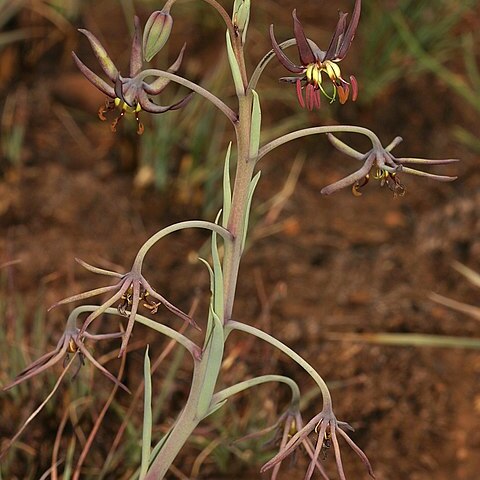Corm oblong-ovoid, up to 4 cm long and 2.5 cm thick, sometimes with a blunt lobe directed vertically downwards; tunics light-to dark-brown, protracted into a neck formed of several loose layers of tissue. Cataphyll whitish to light-brown, apically somewhat dilated, sub-truncate or shortly acute. Stem above-ground part simple or 2-3-branched, 7-70 cm tall, 2-4 mm thick or sometimes very stout, up to 10 mm thick near the base. Leaves (2-)4-7(-12), erecto-patent-spreading-re-curved, lanceolate, (6-)10-30 cm long, (1-)1.5-5 cm wide near the base, apically often rather abruptly tapered to an acute or subobtuse tip, flat or somewhat twisted, rarely with slightly undulating margins, glaucous to somewhat greyish-green. Raceme 5-30 cm long (rarely longer), few-many (up to 25)-flowered. Bracts linear-lanceolate, about 1/2 the pedicel length or less, sometimes longer, lowermost ones larger and more leaf-like. Pedicels erecto-patent to spreading or recurved, eventually sometimes reflexed, (1-)1.5-7 cm long. Perianth actinomorphic with all tepals spreading and eventually reflexed. Tepals (8-)10-23(-25) mm long; claw (1-)2-3.5(-4) mm long; blade lanceolate or linear-lanceolate, 1.5-3.5 mm wide (when expanded), adaxially deep reddish-brown, or brownish-purple to purplish-black, or liver-coloured, maroon, olive-green, or sometimes pale lemon-yellow, often with red or purple margins and nectary region, abaxially dull olive-green or brownish to dull purple, indistinctly or sometimes more distinctly 5-15-veined, acute to sub-obtuse. Nectary margin simple, straight or emarginate, sometimes irregular or undulating, rarely auricled with two small lateral lobes. Filaments usually 1/3 to 2/3 as long as the tepal, 5-13(-16) mm long, filiform or thickened below the middle, 0.3-1 mm thick, usually ± arcuate, the upper 2/3-3/4(-4/5) purplish or mahogany-red, the lower 1/3-1/4(-1/5) white or light greenish, rarely entirely light-coloured. Anthers (2-)2.4-6 mm long, 0.6-1 mm wide, often curved, pale-yellow to light-green or greyish-brown. Styles free right from the base or rarely connate for ca. 0.5 mm, 6-15 mm long, spreading, light-green throughout, or the upper 2/3 purplish and the lower 1/3 light-coloured. Ovary globose or oblong-ovoid, green. Capsule pyriform-globose, 1-2.7 cm long and 1-1.5 cm wide. Seeds globose or sub-globose, 2.5-4 mm in diam., brown or light-brown, almost smooth but usually with a (partial) somewhat tartareous light-brown coat (and at high magnification 'micro-reticulate-rugose'); raphe keel-like or shortly winged.
More
Herb up to 70 cm high; corm oblong-ovoid, up to 4 cm long and 2.5(–4) cm in diameter; stem simple or 2–3, branched, 7–70 cm high; cataphyll up to 7(–14.5) cm long.. Leaves glaucous to somewhat greyish green, (2–)4–7(–12), erecto-patent-spreading-recurved, lanceolate, 10–35 cm long, (1–)1.5–5 cm wide near the base, apex acute to subobtuse.. Raceme 5–30 cm with up to 25 flowers; bracts linear-lanceolate, 1.9–5.5 cm long, 0.1–0.4 cm wide; pedicels 1.5–7 cm long.. Perianth dark brownish, olive-green or sometimes pale lemon-yellow, often with red or purple margins and nectary region; perianth segments lanceolate or linear-lanceolate, (8–)10–23(–25) mm long, 1.5–3.5 mm wide (when expanded), claw (1–)2–3.5(–4) mm long.. Filaments upper parts purplish or mahogany red, lower parts white or light greenish, usually curved, 4–13(–16) mm long; anthers 2.5–6 mm long, often curved.. Ovary globose or ovoid-oblong, green; styles spreading, 6–15 mm long.. Capsule 1–2.5 cm long, 1–1.5 cm in diameter; seeds 2.5–4 mm in diameter.. Fig. 6 (page 16).
Cormous geophyte, 60-200 mm tall. Leaves (2-)4-12, lanceolate. Flowers nodding, actinomorphic, greenish with maroon margins or red to brown, unscented, tepals spreading or reflexed, (8-)10-25 mm long, nectary pouch-like; filaments thickened or swollen below, 5-13 mm long.
Geophyte, up to 1.5 m high. Flowers: pedicels erect to spreading or recurved; perianth with tepals 10-23 mm long, reflexed, nectary margin simple, straight or emarginated, reddish brown, maroon or purplish black; Sep.-Jan. Fruit pyriform-globose, 10-27 x 10-15 mm.
Geophyte, up to 0.7 m high. Pedicels erecto-patent to spreading or recurved. Perianth actinomorphic. Nectary margin simple, straight or emarginate. Tepals 10-23 mm long. Flowers reddish brown, maroon or purplish black.
Like O. parviflorum but flowers larger, filaments 5-13 mm long.

